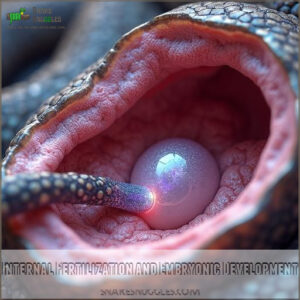This site is supported by our readers. We may earn a commission, at no cost to you, if you purchase through links.
 Ever wondered why snakes rock two penises?
Ever wondered why snakes rock two penises?
It’s nature’s backup plan!
These funky organs, called hemipenes, aren’t just for show.
They’re strategically designed to maximize reproductive success.
Each hemipenis connects to a different testis, letting snakes alternate between them during mating.
This clever setup keeps sperm fresh and boosts their chances of fertilization.
The unique structure—complete with spines and hooks—helps lock things in place during snake romance.
Think of it as a reproductive Swiss Army knife that gives these slithery creatures an evolutionary edge.
Who knew snake reproductive biology could be so wild?
There’s more to these serpentine secrets than meets the eye.
Table Of Contents
- Key Takeaways
- Snakes Unique Genitalia
- Why Two Penises
- Snake Reproductive Biology
- Hemipenes Development
- Snake Mating Behaviors
- Reptile Genitalia Diversity
- Advantages of Two Penises
- Snake Evolution History
- Reproductive Success Factors
- Genetic Research Insights
- Frequently Asked Questions (FAQs)
- Why do snakes have two penises?
- Do penis rings help sustain erections?
- Do snakes have a penis?
- Why do snakes have different genitalia?
- What does it mean if two snakes mate?
- Can a male snake mate with more than one female?
- Why are alligators always erect?
- Do female snakes have two holes?
- What is the purpose of hemipenes?
- Why do snakes mate in a ball?
- Conclusion
Key Takeaways
- You’ve got a genetic backup plan with hemipenes, allowing snakes to alternate between two penises during mating to maximize reproductive success.
- Each hemipene connects to a different testis, giving you fresh sperm delivery and increasing your chances of successful fertilization in the competitive world of snake reproduction.
- You’ll boost your genetic spread by having unique structural features like spines and hooks that help lock into female reproductive tracts during mating.
- Your evolutionary advantage comes from the ability to switch between hemipenes, ensuring higher sperm quality and increasing the likelihood of passing on your genes to the next generation.
Snakes Unique Genitalia
Ever wondered why snakes rock not one, but two penises? You’re in for a wild ride as we uncover the mind-blowing secret behind these slithery creatures’ unique below-the-belt anatomy!
Hemipenes and Their Function
Ever wondered about snake sex secrets?
Hemipenes aren’t just weird – they’re evolutionary superstars! These twin sexual organs give male snakes a serious mating advantage.
By alternating between hemipenes during sperm competition, snakes maximize their chances of reproductive success. It’s nature’s clever backup plan, ensuring these slithery creatures can pass on their genetic legacy with impressive biological efficiency.
Structure of Hemipenes
Now that we’ve explored hemipenes basics, let’s peek under the scales at their mind-blowing structure.
Each hemipenis packs a wild design with unique spines and hooks that help lock into place during mating. Retractor muscles control these fascinating snake sex organs, allowing precise positioning.
Their internal structure varies wildly between species, making each snake’s hemipenes morphology a genetic masterpiece of reptilian reproduction.
Evolution of Hemipenes
Diving into the wild world of hemipenes evolution reveals a mind-blowing genetic mystery. Snake reproductive organs didn’t just happen by chance—they’re a product of complex developmental genetics and sexual selection.
Hemipenes morphology is key to squamate speciation, as detailed on the hemipenes Wikipedia page.
- Hemipenes developed from embryonic cells similar to limb-growth regions.
- Ancestral state suggests a single penis that split during evolution.
- Genetic "Sonic hedgehog" gene plays a necessary role in development.
- Mating advantage drives hemipenes’ unique structural adaptations.
- Sperm competition shapes hemipenes’ evolutionary trajectory.
Why Two Penises
After examining snake anatomy’s quirky secrets, you might wonder why these slithery creatures sport two penises. It’s not just a wild biological prank—it’s a brilliant reproductive strategy!
Snake hemipenes give males a serious mating advantage, letting them alternate between left and right organs during copulation. This double-barreled approach means fresh sperm delivery and increased chances of successful fertilization.
To further enhance their reproductive success, males engage in elaborate snake mating rituals. Think of it like having two fishing rods instead of one—more opportunities to reel in genetic success.
Each hemipenis comes with unique structural features that help lock into female reproductive tracts, ensuring sperm competition works in their favor. Nature’s design isn’t just random—it’s a calculated move in the complex world of snake penis evolution, proving that sometimes two really are better than one.
Snake Reproductive Biology
Ever wondered why snakes sport a double-barreled mating setup that’d make other animals do a double-take?
You’re in for a wild ride through snake reproductive biology, where two penises aren’t just a quirk, but a fascinating evolutionary strategy that’ll make you see these slithery creatures in a whole new light!
Internal Fertilization and Embryonic Development
Ever wondered how snake babies get their start?
Internal fertilization kicks off the wild journey of snake reproduction.
With hemipenes ready to rock, male snakes deposit sperm directly inside the female, bypassing external mating drama.
The embryonic nutrition begins immediately, as the egg morphology supports developing offspring through a fascinating gestation period that’s totally unique in the reptile world.
Understanding snake reproductive biology processes is essential for grasping the nuances of their life cycle.
Factors Influencing Reproductive Success
When nature plays matchmaker, snake reproduction gets wild! Your mating success depends on more than just good looks.
Key factors include:
- Active moves during mating season boost your chances
- Larger body size helps you guard potential mates
- Genetic diversity adds spice to the reproductive game
- Timing and location matter more than you’d think
- Competitive spirit can tip the reproductive scales
Understanding the polygynandrous mating system is important for insight into snake love dynamics.
Snake love is a strategic dance of survival.
Role of Hemipenes in Copulation
During snake copulation, hemipenes play a vital role in their unique mating strategies.
These dual intromittent organs provide snakes with impressive reproductive advantages.
| Hemipene Feature | Mating Advantage |
|---|---|
| Alternate Use | Fresh Sperm Delivery |
| Structural Variation | Species Recognition |
| Competitive Positioning | Increased Fertilization |
| Adaptive Design | Enhanced Reproductive Success |
Their remarkable design guarantees maximum genetic transfer and survival of the species.
Hemipenes Development
Ever wondered why snakes rock a double-barreled reproductive system?
You’ll be amazed to learn that their twin hemipenes aren’t just a random quirk, but a clever evolutionary trick linked to how their leg development got hijacked by some seriously wild genetic magic!
This is the entire text reorganized for better readability.
Relationship Between Hind Legs and Hemipenes
Ever wondered how snake hemipenes relate to their long-lost legs? Buckle up for a wild ride through reptile anatomy!
- Hemipenes develop where hind limbs could have grown.
- Embryonic cells shape both leg and penis structures.
- Genetic magic transforms potential legs into reproductive organs.
- Vestigial leg hints remain in snake anatomy.
You’re witnessing nature’s bizarre blueprint of penis development up close!
Sonic Hedgehog Gene and Limb Growth
Peeling back the genetic curtain reveals a wild tale of the Sonic hedgehog gene’s magical moment in snake embryos.
This tiny genetic conductor briefly orchestrates a symphony of potential limb development before hitting the mute button.
Want to know how? Check out this quick breakdown:
| Gene Action | Embryonic Result |
|---|---|
| Activation | Limb signal |
| Suppression | Hemipenes formation |
| Evolutionary twist | No legs, two penises |
The development of unique features in snakes, such as rattle formation development, highlights the complexity of their evolutionary adaptations.
Buckle up for nature’s most unexpected genetic magic trick!
Genetic Mechanisms Controlling Development
With a twist of genetic magic, snake hemipenes development reveals nature’s wild design.
Molecular genetics tells a fascinating story of cellular regulation and evolution:
- Gene expression drives hemipenes formation
- Developmental biology plays a pivotal role
- Epigenetics influences penis function
- Cellular mechanisms shape snake evolution
- Hemipenes purpose emerges through complex genetic pathways
Scientists unravel how these unique reproductive structures emerge, blending scientific precision with nature’s mysterious blueprint, and exploring the role of molecular genetics in this process, which is a part of nature’s design.
Snake Mating Behaviors
Ever wondered why snakes sport not one, but two penises?
Buckle up for a wild ride into the reptilian world of crazy cool mating behaviors that’ll make you appreciate how nature’s got some seriously weird tricks up its scaly sleeve!
Role of Hemipenes in Mating
At the heart of snake mating, hemipenes play a pivotal role in sperm competition and fertilization success.
These dual intromittent organs give snakes an advantage in mate choice, allowing alternating use during copulation.
By switching hemipenes, males can maximize their reproductive potential, increasing chances of successful fertilization in the wild reptile world.
Process of Intromission
Someone might wonder how snakes get down to business during reptilian romance.
The process of hemipenis insertion is a wild ride of reptilian romance.
Here’s what happens during snake mating:
- Both partners align their cloacas with precision
- One hemipenis springs into action
- Snakes engage in an intricate dance of reproductive prowess
- Female receptivity determines the magical moment
Cloacal contact triggers the intricate sperm transfer, with mating duration varying between species.
Fertilization and Successful Mating
After traversing the intricate dance of intromission, successful fertilization becomes a high-stakes game for snakes.
Their unique hemipenes aren’t just a quirky feature—they’re a strategic weapon in the reproductive arena.
| Mating Strategy | Reproductive Outcome |
|---|---|
| Alternating Hemipenes | Increased Sperm Diversity |
| Competitive Copulation | Higher Genetic Variation |
Sperm competition drives these slithery Casanovas to maximize their chances of passing on genes, turning each mating encounter into a biological lottery, which involves reproductive arena and genetic variation.
Reptile Genitalia Diversity
Ever wondered why some reptiles rock not one, but two sexual organs?
Get ready to unravel the wild world of reptile genitalia, where nature’s quirky design proves that having a backup plan isn’t just smart—it’s downright survival of the sexiest!
Variety of Genital Structures in Reptiles
After exploring snake mating behaviors, let’s peek into the wild world of reptile anatomy.
Reptile genitalia are mind-blowing in their diversity, from spiky structures to permanently erect organs, nature’s got some serious surprises up its sleeve.
Check out these jaw-dropping facts about reptilian reproductive traits:
- Hemipenes come in crazy shapes and sizes
- Lizards rock two-part genital systems
- Some species have hook-like appendages
- Evolutionary adaptations blow your mind
- Herpetology reveals mind-bending reproductive secrets
Research on Female Reptile Genitalia
After exploring reptile genitalia’s wild variations, we’re zooming in on female reptile anatomy. Scientists have uncovered fascinating insights about snake reproductive structures, revealing hidden biological marvels.
Female snakes pack surprises with their unique two-clitoris setup – a mirror image of male hemipenes that’s still mostly mysterious. The study of reptile genitalia involves understanding reptile genital anatomy (reptile genital anatomy).
| Feature | Details |
|---|---|
| Location | Inside body |
| Structure | Paired erectile tissues |
| Size | Smaller than male hemipenes |
| Visibility | Challenging to study |
| Function | Not fully understood |
Hemiclitores and Their Function
After peeking into female reptile genitalia, let’s zoom in on hemiclitores – the lesser-known counterparts to male hemipenes.
These tiny, paired structures sit inside female reptiles, mirroring the male’s intromittent organs.
Unlike human anatomy, snake hemiclitores are vestigial yet fascinating, hinting at the wild reproductive diversity lurking in the reptile world.
Advantages of Two Penises
Ever wondered why snakes rock two penises like some kind of reptilian superhero?
They’ve got a wild evolutionary trick up their scale-covered sleeve that boosts their chances of scoring reproductive success and keeps their species thriving.
This reproductive success is key to their survival, and it is a fascinating aspect of their biology.
Increasing Chances of Reproductive Success
Ever wondered why snakes rock two penises? It’s all about boosting those mating strategies and reproductive fitness!
Here’s the scoop on their wild genetic advantage:
- Maximize chances of successful fertilization
- Increase genetic variation opportunities
- Spread reproductive potential across different females
- Overcome challenges in snake mating environments
- Enhance overall sperm quality and delivery efficiency
Nature’s got some seriously clever tricks up its sleeve, utilizing genetic advantage to ensure survival.
Alternating Use of Hemipenes for Fresh Sperm
Some snakes play a sperm storage game that’d make fertility experts raise their eyebrows.
By alternating hemipenes during mating, they guarantee fresh sperm delivery and maximize reproductive success.
This clever strategy lets each hemipenis rest and recharge, guaranteeing premium sperm quality and increasing the chances of fertilization in their wild, competitive reptile world, which is key to their reproductive success.
Adaptive Benefits of Hemipenes
Nature’s got a brilliant plan after snakes cycle through those hemipenes like a finely-tuned reproductive machine. These twin tools give snakes mating strategies that boost reproductive advantage.
By alternating between hemipenes, they maximize sperm competition and increase genetic diversity. It’s like having a backup drive for evolution – ensuring these slithery creatures keep winning the survival game with their clever genital evolution.
Understanding the role of ball python sexing methods is vital in appreciating the nuances of their reproductive biology.
Snake Evolution History
Ever wondered how snakes evolved from slithering with legs to becoming the smooth, legless creatures we’re familiar with today?
Their weird two-penis setup is actually a fascinating glimpse into millions of years of reptilian transformation, where genetic quirks and survival strategies reshaped their entire bodily design, including the development of legless creatures.
Development of Genitalia in Reptiles
So you’re wondering how reptile genitalia actually develop?
Buckle up for a wild ride through snake biology! Genetic coding plays a key role in shaping their unique hemipenes.
Embryonic growth reveals fascinating insights into species variation, with the cloaca orchestrating this intricate dance of evolutionary advantage.
Who knew reproductive anatomy could be so mind-blowingly complex?
Vestigial Hind Leg Bones in Snakes
Hold onto your biology hats! Those tiny bone remnants hiding in snake anatomy are jaw-dropping evidence of their wild evolutionary past.
Check out these incredible leg fossil clues:
- Microscopic hip bone structures reveal prehistoric snake mobility
- Some snake species still carry genetic "leg memory"
- Embryonic development hints at ancient walking ancestors
- Vestigial traits prove complex reptile transformation stories
- Male snake anatomy preserves evolutionary roadmaps
Nature’s got some seriously cool biological breadcrumbs tucked away in snake DNA, which is a remarkable example of vestigial traits.
Evolutionary Link Between Legs and Penises
Imagine a genetic twist where your leg could become a penis.
During embryonic growth, the Sonic hedgehog gene briefly sparks leg development in reptiles.
Evolution’s quirky design transforms ancestral traits, positioning hemipenes exactly where hind legs once grew.
This wild genetic control reveals how snake genitalia emerged from the remnants of leg-building blueprints.
Reproductive Success Factors
You might think one snake penis is wild enough, but two hemipenes are nature’s ultimate reproductive insurance policy.
These specialized organs aren’t just a genetic quirk—they’re a clever evolutionary strategy that boosts a snake’s chances of passing on its genes and ensuring the survival of its species.
Role of Hemipenes in Ensuring Fertilization
From legless ancestors to modern marvels, snake hemipenes play a game-changing role in fertilization success.
These dual reproductive tools maximize genetic spread by alternating sperm delivery, increasing the odds of successful mating.
By switching between hemipenes, male snakes can optimize sperm quality and boost their chances of passing on their genes to the next generation, which is crucial for genetic spread.
Importance of Hemipene Structure for Mating
After ensuring fertilization, your snake’s hemipene structure becomes a game-changer.
Those spiny, hooked organs aren’t just random—they’re precision tools for mating success.
Each hemipenis connects to a separate testis, letting snakes alternate sperm delivery like a reproductive tag team.
This genius design maximizes their chances of passing on those slithery genes.
Genetic Research Insights
Ever wondered how snake scientists crack the code of reptilian reproduction? You’ll be shocked to learn that cutting-edge genetic research is unraveling the mind-blowing mysteries behind snakes’ double-barreled love tools!
Genetic Mechanisms Driving Genital Development
Enter the wild world of snake genitalia, where genetic controls shape the most fascinating reproductive structures in nature.
The molecular magic behind reptile hemipenes unfolds through intricate developmental biology processes.
- Cellular differentiation drives hemipenis formation
- Genetic mutations spark unique structural changes
- Embryonic signals orchestrate complex genital development
- Molecular genetics reveals reproductive mysteries
Snakes’ reproductive toolkit reveals nature’s ingenious design through precise genetic programming, showcasing the molecular magic and reproductive mysteries of these creatures.
Research on Snake and Human Genital Development
Researchers like Clifford Tabin and Patrick Tschopp have cracked open the wild world of snake and human genital development.
Their Harvard-led study reveals how genetic mechanisms shape reproductive anatomy differently in reptiles and mammals.
By exploring comparative anatomy and developmental biology, they’ve uncovered fascinating insights into how "Sonic hedgehog" genes play a role in this quirky genetic puzzle.
The study of snake genitalia, including snake genital products, has also provided valuable information on the unique characteristics of reptile reproductive systems.
Implications of Genetic Research for Medical Studies
A peek into snake genitalia research might just crack open revolutionary medical mysteries.
Genetic studies on hemipenes reveal unexpected pathways for understanding developmental disorders and personalized medicine potential.
By exploring reptilian embryonic development, scientists uncover unique insights into evolutionary medicine applications that could transform how we approach genetic disease treatment.
Understanding the role of snake breeding genetics is essential in deciphering the nuances of reptilian development and its potential implications for human medicine.
Frequently Asked Questions (FAQs)
Why do snakes have two penises?
You’ve got two hemipenes because evolution’s playing matchmaker.
These backup reproductive organs help snakes navigate tricky mating situations, boost their chances of successful reproduction, and provide a genetic advantage in the wild.
Do penis rings help sustain erections?
One night stand gone wrong?
Penis rings can help maintain erections by restricting blood flow, creating a firmer, longer-lasting experience.
They’re like a temporary boost for guys struggling with performance, but consult a doc first.
Do snakes have a penis?
Yes, snakes have two hemipenes tucked inside pouches near their tail.
These specialized organs help them mate effectively, with one used at a time during reproduction, showcasing nature’s fascinating and unique reproductive strategies.
Why do snakes have different genitalia?
You’ve got unique snake genitals thanks to evolutionary adaptation! Their double hemipenes help with mating success, species recognition, and competitive reproduction strategies, allowing flexible reproductive opportunities in the animal kingdom.
What does it mean if two snakes mate?
When two slithery lovers intertwine, they’re engaged in a fascinating mating ritual where one male uses his single hemipenis to fertilize the female’s eggs.
This process ensures species continuation through a complex dance of reproduction.
Can a male snake mate with more than one female?
Male snakes can definitely mate with multiple females during breeding season.
Their two hemipenes give them an evolutionary advantage, allowing them to compete and increase their chances of successful reproduction across different partners, which is a significant aspect of their breeding season.
Why are alligators always erect?
In alligators, permanently erect penises aren’t just about size—they’re an evolutionary adaptation.
These always-ready organs help males quickly mate during brief breeding windows, ensuring reproductive success in their competitive, swampy world.
Do female snakes have two holes?
Female snakes rock two reproductive holes, called cloacae.
They’re used for different purposes: one is for waste and another for egg-laying and mating.
They’re strategically placed to keep things functional and efficient in the reptile world.
What is the purpose of hemipenes?
Yo, time-travel to snake mating basics! Hemipenes are dual reproductive organs that help snakes mate more effectively, allowing alternate use during breeding and potentially increasing reproductive success in competitive scenarios.
Why do snakes mate in a ball?
When multiple male snakes compete for a female, they form a mating ball, wrestling and entwining to determine who’ll successfully reproduce.
It’s nature’s wild matchmaking dance, where only the most persistent suitor gets his shot.
Conclusion
Buckle up for a mind-blowing revelation about why snakes have two penises.
Nature’s ingenious design of hemipenes isn’t just a quirky biological trick—it’s a survival strategy.
You’ll be amazed by how these dual reproductive organs boost mating success, allow sperm freshness, and give snakes a reproductive advantage.
Understanding why snakes have two penises reveals the incredible adaptations that help these slithery creatures safeguard their genetic legacy in the wild, proving once again that evolution is the ultimate problem-solver.
- https://snakesarelong.blogspot.com/2014/03/why-do-snakes-have-two-penises.html
- https://www.popsci.com/science/why-do-snakes-have-two-penises/
- https://en.wikipedia.org/wiki/Hemipenis
- https://hms.harvard.edu/news/scientists-think-they-know-why-snakes-get-two-penises-people-only-get-one
- https://www.kingsnake.com/blog/archives/2438-Why-do-snakes-have-two-penises.html




















